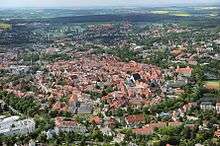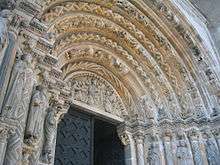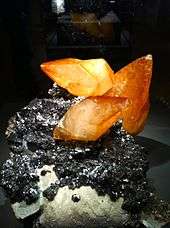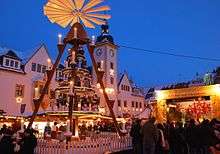Freiberg
Freiberg is a town in Saxony, Germany. It has one of the best preserved historic town centres in the state, and is known for its cathedral and centuries-old mining tradition. It is seat of the Bergakademie TU Freiberg, the second oldest technical university still in existence.
Understand


Freiberg was founded in the 1160s, on the northeastern slopes of the Saxon Ore Mountains. It became the biggest city and prime trading centre in the Margraviate of Meissen (precursor of the state of Saxony) during the high Middle Ages. The nearby Ore Mountains' abundance in silver ore, combined with the right of coinage, made Freiberg one of the richest towns, and the Electorate of Saxony one of the richest states in Germany. Silver mining ceased in the 20th century. Since then, Freiberg has undergone a structural transformation, redefining itself as a centre of high technology with semiconductor production and solar engineering, belonging to the so-called "Silicon Saxony".
The Bergakademie (mining academy) was established in 1765 as one of the first colleges for mining technology in the world. It has been promoted to a university. It defines itself as a "natural resources university" and offers courses and research related to geosciences, materials and environmental science, energy research, engineering, mathematics and natural science. The town has about 42,000 inhabitants, 5,000 of whom are university students. Due to the focus on natural sciences and technology, more than two thirds of the students are male.
Get in
By plane
From Dresden Airport (DRS IATA) it is a bit over an hour by train to Freiberg. Take the S-Bahn to either Dresden Neustadt or Dresden Hauptbahnhof and then a regional train to Freiberg from there.
By train
- 🌍 Freiberg (Sachs) station. There are no intercity trains serving Freiberg: it is only reached by hourly "regional express" trains from Dresden and Chemnitz (taking half an hour each), Zwickau (one hour) and Hof (two hours), and slower regional trains (35 minutes from Chemnitz, 45 minutes from Dresden).
By car
Freiberg is about 16 km off the autobahn A 4 (exit Siebenlehn or Berbersdorf). It is crossed by the B 173 road that links Dresden with Chemnitz, and by the B 101 between Meißen and the Ore Mountains.
Get around
Regiobus Mittelsachsen operates 9 urban bus lines in Freiberg.
The historic town centre has a diameter of just over 1 km and is best discovered on foot.
See
The historic town centre has maintained its original layout from the Middle Ages, and unlike the centres of most German cities, it was not destroyed in any war. The most important buildings are centered on the Untermarkt ("lower market") and Obermarkt ("upper market")

- 🌍 St Mary's Cathedral (Dom St. Marien), Untermarkt. Most of the cathedral is late-Gothic dating from the late 15th century, after its predecessor mostly burned down during a big town fire. Fortunately the original, elaborately decorated and sculptured Romanesque portal survived. It is one of the most outstanding pieces of 13th-century art in Germany. Another notable artwork within the cathedral is the unconventionally formed late-Gothic "tulip pulpit". The cathedral's choir contains the burial place of the Saxon prince-electors and their families from the 16th to late 17th century and has lavish Baroque decorations.
- 🌍 St Peter's Church (Petrikirche), Petriplatz. Late-Romanesque basilica from c. 1200. The higher of its two towers is 72 m high and stands on the highest point of the city (405 m above sea level). It is Freiberg's best-known landmark and can be seen from many places in the wider region.
- 🌍 St Nicholas' Church (Nikolaikirche). The first church here was built the late 12th century in the Romanesque style. It was rebuilt several times, now showing a mostly Baroque style. It was secularised in 1975 and is used as a concert hall and event location.

- 🌍 Freudenstein Castle and Terra mineralia (Schloss Freudenstein), Schloßplatz 4, ☎ +49 3731 394654. M-F 10:00-17:00, Sa Su 10:00-18:00. The castle is as old as the city and was built to protect mining and trade. Some of Saxony's electors resided here most of the time and some of their princes were born here. In the second half of the 16th century, it was transformed into a more comfortable Renaissance-style palace. In 1784, the military took over the building and converted it to an arms depot. Nowadays, it houses the world's largest collection of minerals, gems and meteorites that was donated by a private collector to the University of Freiberg. Admission €12 (reduced €6).
- 🌍 Museum of local history and mining (Stadt- und Bergbaumuseum Freiberg), Am Dom 1, ☎ +49 3731 20250, e-mail: info@museum-freiberg.de. In a Gothic gabled cathedral canon residence.
_2006-11-08.jpg)
- 🌍 Himmelfahrt show mine (Himmelfahrt Fundgrube, Besucherbergwerk Freiberg), Fuchsmühlenweg 9, ☎ +49 3731 394571. 300-year old silver mine, used to demonstrate the history of mining during different eras. There are different tours, from 45 minutes to 5 hours, illustrating geology, history and technology of eight centuries. Tours €13–40 (reduced €6–35).
- 🌍 Museum of beds and sleeping (Betten- und Schlafmuseum), Bahnhofstr. 28, ☎ +49 3731 355290. M-F 09:00-18:00, Sa 09:00-12:00, closed on Sundays. Admission free.
- 🌍 Jakobikirche.
Do

- Christmas fair in December
- Mining parade, second Saturday of Advent
Buy
Learn
- 🌍 Technische Universität Bergakademie Freiberg. The town's main claim to fame and one of the oldest technological universities in the world, only beaten out by the École nationale des ponts et chaussées in Paris. Founded in 1765 as a mining school it has since branched out into other fields of the technical sciences but still has a focus on mining and geology, in part due to the history of the town.
Eat
Drink
Sleep
- Mercure Hotel Panorama Freiburg, Wintererstraße 89, ☎ +49 761 51030.
Connect
Go next
- Dresden, 40 km northeast (half an hour by train)
- Chemnitz, 35 km southwest (half an hour by train)
- Freital, 28 km northeast (half an hour by train)
- Meißen, 40 km north